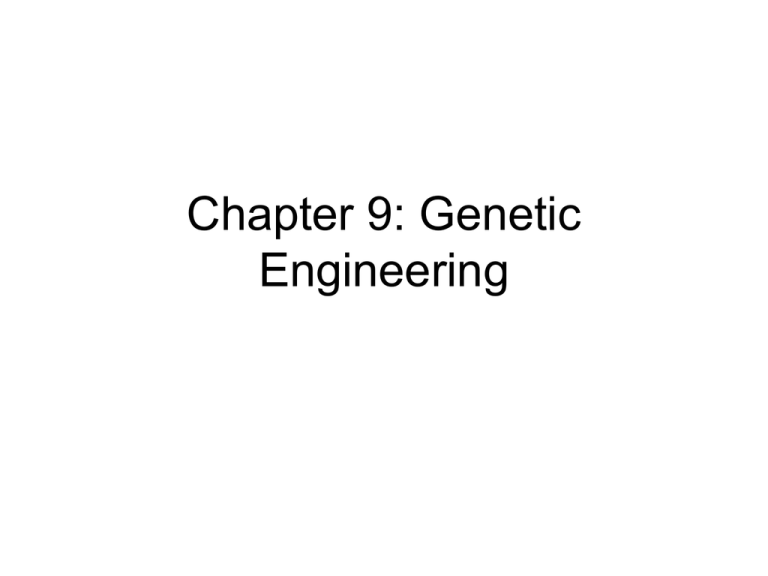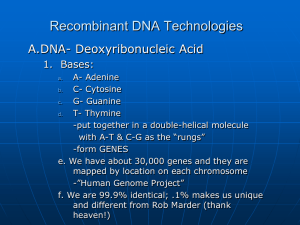Genetic Engineering Power Point
advertisement

Chapter 9: Genetic Engineering Why do these pigs glow in the dark? Normal pig genes + GFP jelly fish gene + GFP = Green Fluorescent “Pig”ment Selective Breeding • Has been occurring for thousands of years Ex: (dog breeds, agriculture) – – Takes advantage of naturally occurring traits in a population Two types Selective Breeding • Hybridization: crossing two dissimilar organisms to get the best traits of both organisms – – hybrids are often hardier/stronger than either parent ex: mules (cross between horse and donkey), ligers (lion/tiger) LIGER • Male lion + female tiger Tigon • Male tiger + female lion Leopon • Male Leoplard + female lion Mule • Male donkey + female horse Hinny • Male horse + female donkey Huck • Male horse + female duck Sea Rex • Female T-Rex + male sea horse Turger • Male turtle + cheese burger Selective Breeding • Inbreeding: crossing two organisms that are very similar to retain desirable characteristics. – Can lead to recessive genetic disorders appearing frequently because the organisms are so similar genetically. • – Why would recessive genetic disorders be seen more often? Ex. Maintaining “purebred” dog breeds Increasing Variation • If the desired characteristic is not present, scientists have induced mutations in hope of it causing the right effect Success stories: • – Oil-eating bacteria- used to clean up oil spills Creating polyploidy (3+ sets of chromosomes) plants- usually larger and stronger – • Examples: bananas, citrus Genetic Engineering • That was the “old” way of manipulating inheritance. Now, we can isolate specific DNA sequences and modify the code in what is called genetic engineering. How do they get it out of the cells? o DNA extraction- lysing the cells and separating the excess cell parts from the DNA by using a centrifuge Dissolved DNA cell junk Restriction enzymes cut DNA. • Restriction enzymes act as “molecular scissors.” – come from various types of bacteria – allow scientists to more easily study and manipulate genes – cut DNA at a specific nucleotide sequence called a restriction site How do they cut the pieces they want? • Restriction enzymes- they cut DNA at a specific site – (100s of them that identify different sequences of base pairs know as recognition sequences- they are a palindrome- read the same 5’-3’ in each direction) – CTTAAG is cut CTTAAG GAATTC GAATTC – some cut straight across and leave “blunt ends” – some make staggered cuts and leave “sticky ends” – Sticky Ends – refers to the two ends of DNA after being cut by a restriction enzyme because they reattach to a complementary end very easily because of chemical attractions How are the pieces identified? • Using gel electrophoresis • Different fragments end up being different lengths • They are run through gel electrophoresis where electrical current pull DNA fragments through an agarose gel. DNA mixtures are placed in a well in agarose and electrical current is switched on. • The small fragments travel faster, and the larger fragments cannot travel as far. DNA fingerprint produced by gel electrophoresis • Different restriction enzymes cut DNA in different ways. – each enzyme has a different restriction site – Smaller fragments move faster and travel farther than larger fragments. – Fragments of different sizes appear as bands on the gel. • A restriction map shows the lengths of DNA fragments between restriction sites. – only indicate size, not DNA sequence – useful in genetic engineering – used to study mutations A DNA fingerprint is a type of restriction map. • DNA fingerprints are based on parts of an individual’s DNA that can by used for identification. – – – – based on noncoding regions of DNA noncoding regions have repeating DNA sequences number of repeats differs between people banding pattern on a gel is a DNA fingerprint DNA fingerprinting is used for identification. • DNA fingerprinting depends on the probability of a match. – Many people have the same number of repeats in a certain region of DNA. – The probability that two people share identical numbers of repeats in several locations is very small. (mother) (child 1) (child 2) (father) – Individual probabilities are multiplied to find the overall probability of two DNA fingerprints randomly matching. 1 x 1 x 1 = 1 = 1 chance in 5.4 million people 500 90 120 5,400,000 – Several regions of DNA are used to make DNA fingerprints. • DNA fingerprinting is used in several ways. – – – – evidence in criminal cases paternity tests immigration requests studying biodiversity – tracking genetically modified crops Genetic Engineering • Gene sequencing: using a gel electrophoresis method () or using a machine (below), scientists can figure out genes and entire genomes (all the genes in an organisms) How can we sequence DNA? • Mix unknown DNA fragment with DNA polymerase and nucleotides to copy the DNA. • The nucleotides added will also have special dideoxynucleotides (didNTP) with attached dyes. • Newly synthesized DNA will be made but will stop each time a didNTP nucleotide is added. How can we sequence DNA? • The DNA is run on a gel and the fragments will make a colored banding pattern in the order of bases (A, T, G, or C) • Watch the animation on the website highlighted in the resources page of my website. Genetic Engineering – We can now find and isolate certain genes. • • • – you can test for certain genetic disorders, and predict chances of inheritance scientists can study the gene’s function and how to treat people with the genetic disorder Ex: what gene causes diabetes? Breast cancer? We have completed the Human Genome Project mapping all human genes Gene Therapy • • Gene Therapy: a faulty gene is replaced with a normal working gene See a real gene therapy success story with a blind dog (click) How do we get a lot of copies of a specific DNA sequence we want? • PCR- Polymerase Chain Reaction – a primer is added to the beginning of the isolated desired gene – DNA is heated to break the hydrogen bonds between the nitrogenous bases – DNA polymerase attaches and replicated sides, using both as templates – Copies are made at an exponential rate of only the desired gene (much faster than cloning) PCR uses polymerases to copy DNA segments. • PCR makes many copies of a specific DNA sequence in a few hours. target sequence of DNA • PCR amplifies DNA samples. • PCR is similar to DNA replication. • Each PCR cycle doubles the number of DNA molecules. Recombinant DNA • Manipulating the presence or absence of a gene by adding or cutting out gene sequences • Combining DNA from two different sources by cutting with the same restriction enzymes creates DNA that has been modified • Transformation- a cell takes in DNA from outside the cell and incorporates it into its own DNA (bacterial plasmids, chromosomes in plants and animals) New genes can be added to an organism’s DNA. • Recombinant DNA contains genes from more than one organism. (bacterial DNA) • Bacterial plasmids are often used to make recombinant DNA. – plasmids are loops of DNA in bacteria – restriction enzymes cut plasmid and foreign DNA – foreign gene inserted into plasmid Genetic engineering produces organisms with new traits. • A transgenic organism has one or more genes from another organism inserted into its genome. Applications of Genetic Engineering Transgenic bacteria: • • • can produce human insulin (for diabetes) human growth hormone (for Turner’s syndrome) blood clotting factor (for hemophilia) Transgenic Organisms • Transgenic animals: – study human genes in animals – produce organisms that can make human proteins – cows that can grow faster with multiple copies of growth hormone A natural protein produced in the milk of GEM and other transgenic cows kills the bacteria that cause mastitis. • Transgenic animals are used to study diseases and gene functions. – transgenic mice used to study development and disease – gene knockout mice used to study gene function Transgenic Organisms • Transgenic plants: genetically modified foods – seedless grapes and watermelons – rice with vitamin enhancement – pest-resistant crops (so chemical pesticides do not need to be used) • Scientists have concerns about some uses of genetic engineering. – possible long-term health effects of eating GM foods – possible effects of GM plants on ecosystems and biodiversity TRANSGENIC ORGANISM GONE WRONG!! Cloning – Cloning: creating an organism whose genes are exactly the same as a single parent • • All bacteria and organisms that reproduce asexually are technically clones Multicellular organisms are not as easy to clone- a mammal was cloned officially in 1997—Dolly Cloning • The nucleus of an adult, donor egg is removed • This empty egg is fused with another adult somatic cell’s NUCLEUS (diploid, 2N) • The cell is stimulated with electric shock to divide normally by mitosis and the zygote is implanted into a surrogate mother • The baby is born of the surrogate and has the EXACT same genes as the organism who donated the 2N nucleus. The difference between regular reproduction and cloning (click) Cloning videos • Scientists removing the Egg nucleus: • http://learn.genetics.utah.edu/content/cloni ng/whatiscloning/ Cloning- practice • Clone Mimi the mouse! (click) Genetics provides a basis for new medical treatments. Genetic screening can detect genetic disorders. • Genetic screening involves the testing of DNA. – determines risk of having or passing on a genetic disorder – used to detect specific genes or proteins – can detect some genes related to an increased risk of cancer – can detect some genes known to cause genetic disorders DMD N Gene therapy is the replacement of faulty genes • Gene therapy replaces defective or missing genes, or adds new genes, to treat a disease. • Several experimental techniques are used for gene therapy. – genetically engineered viruses used to “infect” a patient’s cells – insert gene to stimulate immune system to attack cancer cells – insert “suicide” genes into cancer cells that activate a drug What are some concerns with this new Biotechnology? • Ethics: moral principles and values that a society should adhere to in determining the use of scientific discoveries What are some concerns with this new Biotechnology? • What is ethically acceptable to use while testing on animals? • What could genetically modified crops do to the environment? • What does consuming genetically modified food do to us long term? What are some concerns with this new Biotechnology? • Once able to find and fix faulty genes with gene therapy, what is the line we draw on fixing genes? Could we fix not only faulty genes, but undesirable ones? • Could we choose our children’s eye color? • If we can test for genetic disorders at birth, who can access this information? Could discrimination occur based on your genes?






